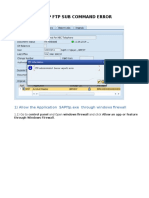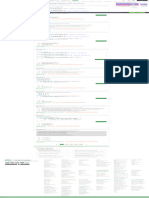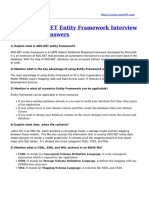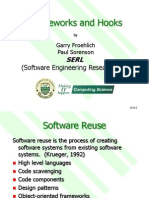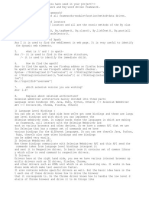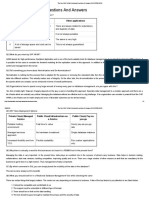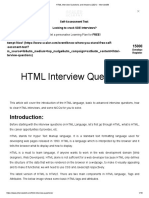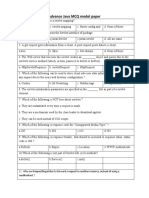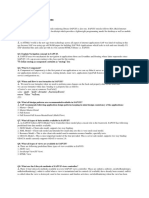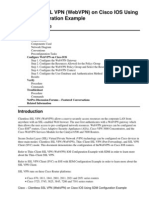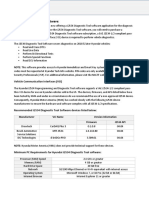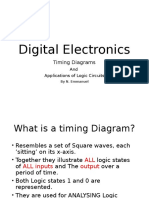0 ratings0% found this document useful (0 votes)
46 viewsSAPUI5 Interview Questions
SAPUI5 Interview Questions
Uploaded by
shailendubey17This document contains 16 questions and answers about SAPUI5. It discusses what SAPUI5 is, why SAP developed it, how navigation works in SAPUI5, what components and views are, the different types of data models and views available, and how to bind data and bootstrap SAPUI5 applications. It also covers fragments, metadata annotations, and common lifecycle methods of view controllers.
Copyright:
© All Rights Reserved
Available Formats
Download as DOCX, PDF, TXT or read online from Scribd
SAPUI5 Interview Questions
SAPUI5 Interview Questions
Uploaded by
shailendubey170 ratings0% found this document useful (0 votes)
46 views2 pagesThis document contains 16 questions and answers about SAPUI5. It discusses what SAPUI5 is, why SAP developed it, how navigation works in SAPUI5, what components and views are, the different types of data models and views available, and how to bind data and bootstrap SAPUI5 applications. It also covers fragments, metadata annotations, and common lifecycle methods of view controllers.
Original Description:
Imp FAQ
Copyright
© © All Rights Reserved
Available Formats
DOCX, PDF, TXT or read online from Scribd
Share this document
Did you find this document useful?
Is this content inappropriate?
This document contains 16 questions and answers about SAPUI5. It discusses what SAPUI5 is, why SAP developed it, how navigation works in SAPUI5, what components and views are, the different types of data models and views available, and how to bind data and bootstrap SAPUI5 applications. It also covers fragments, metadata annotations, and common lifecycle methods of view controllers.
Copyright:
© All Rights Reserved
Available Formats
Download as DOCX, PDF, TXT or read online from Scribd
Download as docx, pdf, or txt
0 ratings0% found this document useful (0 votes)
46 views2 pagesSAPUI5 Interview Questions
SAPUI5 Interview Questions
Uploaded by
shailendubey17This document contains 16 questions and answers about SAPUI5. It discusses what SAPUI5 is, why SAP developed it, how navigation works in SAPUI5, what components and views are, the different types of data models and views available, and how to bind data and bootstrap SAPUI5 applications. It also covers fragments, metadata annotations, and common lifecycle methods of view controllers.
Copyright:
© All Rights Reserved
Available Formats
Download as DOCX, PDF, TXT or read online from Scribd
Download as docx, pdf, or txt
You are on page 1of 2
SAPUI5 Interview Questions
Q1. What is SAPUI5?
A. Just like any other HTML5 client-side rendering library SAPUI5 is also one. SAPUI5 strictly follows RIA (Rich Internet
Application) standards. It is based on JavaScript which provides a lightweight programming model for desktop as well as mobile
applications.
Q2. Why SAPUI5?
A. As HTML5 world is the new age front technology across all aspect of internet applications SAP was kind of trailing in this
age because SAP was using age old WebDynpro for building SAP Web Applications which lacks in rich and user friendly UI.
SAP identified this and came up with its own custom HTML5 library i.e. SAPUI5.
Q3. Explain Navigation concept in SAPUI5.
A. SAPUI5 uses two mechanism for navigation in applications those are EventBus and Routing where latter supersedes since
SAPUI5 1.16. sap.ui.core.routing is the class used for the routing.
We define routing in components metadata in routing key.
Q4. What is Component?
A. Component or Component.js is the first point of our application or we can say bthat it serves as index which encapsulates all
our applications details i.e. view names, routing details, main view, applications type(Full Screen or SplitApp), application
service configuration etc..
Q5. When and How to use formatter in SAPUI5?
A. We need to use formatter when we need to perform some changes on the back end property data on the front end.
we can use formatter while data binding to a property like as follows:
oControl = new sap.ui.commons.TextField({
value : {path : /path, formatter : function(oEvent){
return Value:+oEvent;
}}});
Q6. What all design patterns are recommended/available in SAPUI5?
A. SAP recommends following application design patterns keeping in mind design consistency of the applications:
1. Master Detail
2. Master-Master-Detail
3. Full Screen
4. Full Screen-Full Screen-MasterDetail (Multi Flow)
Q7. What all types of data models available in SAPUI5?
A. As SAPUI5 follows MVC(Model-View-Controller) there model plays crucial role in the framwork. SAPUI5 has following
predefined four data models available:
1. JSON Model Client-side model, supports two way binding.
2. XML Model Client-side model and intended for small data sets this is very rarely used model.
3. Resource Model This is also client side model used to maintain resource bundles, specially texts.
4. ODATA Model This is most important model of the four provided. This is server side model, supports two way binding
ODATA model currently supports ODATA version 2.0.
Q8. What all types of views are available in SAPUI5?
A. There are following predefined three types of view available in SAPUI5:
1. JSON view
2. JavaScript View(JS View)
3. HTML View
Q9. What are the Lifecycle methods of SAPUI5 views controller?
A. There 4 four Lifecycle methods available in every SAPUI5 views controller. These are onInit(), onExit(), onAfterRendering(),
onBeforeRendering(). onInit is called when a view is instantiated and its controls (if available) have already been created; onExit
is called when the view is destroyed; used to free resources and finalize activities; onAfterRendering when the view has been
rendered and, therefore, its HTML is part of the document; onBeforeRendering is called before the controller view is re-rendered
and not before the first rendering.
Q10. What is the main difference between OData Model and JSON Model?
A. The JSON model is a client-side model and, therefore, intended for small datasets, which are completely available on the
client.The OData model is a server-side model: the dataset is only available on the server and the client only knows the currently
visible rows and fields.
Q11. What are SAPUI5 Fragments?
A. Fragments are very light weight UI controls and part of another UI. Fragments are not completely like views but they act like
a view. Fragments are defined similar like views and are names like myFragment.fragment.xml.
Q12. Does Fragment have its own controller?
A. Fragments are created without controllers, they dont have their own controllers they share controller of the view which is
invoking it.
Q13. In how many ways you can bind data to your controls?
A. We can bind data to any controls using three methods, Property, Element and Aggregation binding.
Q14. What is SAPUI5 Bootstrapping?
A. SAPUI5 Bootstrapping means loading and initializing SAPUI5 in any HTML page. The most important library or resource
loaded in SAPUI5 bootstrap is sap-ui-core.js. Apart from this theme for the application, SAPUI5 libraries etc are declared in
the bootstrapping
Q15. What is Metadata Annotations?
A. The service metadata document describes the structure of all resources in the service. This structural metadata makes it easy to
understand a service. We can explore service metadata at the address $metadata relative to the service root.
Q16. What are common Metadata Annotations?
A. Following are some of the service metadata annotations which are common and a front end developer must know these in
order to understand the service and integrate it:
-edm:EntityContainer
-edm:EntitySet
-edm:EntityType
-edm:Property
-edm:NavigationProperty
-edm:AssociationSet
You might also like
- Smooth Transition For Cloud DevlopmentDocument34 pagesSmooth Transition For Cloud DevlopmentderikmacedoNo ratings yet
- Q Type Level Categoryskill SubskilltopicDocument8 pagesQ Type Level Categoryskill SubskilltopicSettiNagarajuNo ratings yet
- How To Fix Sap FTP Sub Command ErrorDocument4 pagesHow To Fix Sap FTP Sub Command Errorsham777779567No ratings yet
- SAPUI5-FIORI Interview QuestionsDocument34 pagesSAPUI5-FIORI Interview Questionsgaurav100% (1)
- Onboarding Checklist TemplateDocument2 pagesOnboarding Checklist Templateshailendubey17No ratings yet
- SAP UI5 Interview QuestionsDocument2 pagesSAP UI5 Interview QuestionslbabNo ratings yet
- Introduction Into Object Orientation - Oops Introduction Into Object OrientationDocument30 pagesIntroduction Into Object Orientation - Oops Introduction Into Object OrientationManoj MahajanNo ratings yet
- How To Write A Routine For 0FISCPER in InfoPackage Selection-1Document16 pagesHow To Write A Routine For 0FISCPER in InfoPackage Selection-1vtsuriNo ratings yet
- DDOS Attack Using KaliDocument10 pagesDDOS Attack Using KaliAJGMFAJNo ratings yet
- Megatel MUX ManualDocument60 pagesMegatel MUX ManualkotafiNo ratings yet
- LiveCycle Designer - 11 - Help PDFDocument713 pagesLiveCycle Designer - 11 - Help PDFSetoIchidakaNo ratings yet
- What Are The Types For Data Binding Modes in WPF?Document10 pagesWhat Are The Types For Data Binding Modes in WPF?akongaraNo ratings yet
- Top 50 SAP ABAP Interview Questions and Answers PDFDocument12 pagesTop 50 SAP ABAP Interview Questions and Answers PDFbarun581No ratings yet
- MCQ Exam SystemDocument24 pagesMCQ Exam SystemloveNo ratings yet
- 50 Java Language MCQs With Answers - GeeksforGeeksDocument1 page50 Java Language MCQs With Answers - GeeksforGeekssurafelhnsNo ratings yet
- Jasmine JavaScript Testing - Second Edition - Sample ChapterDocument11 pagesJasmine JavaScript Testing - Second Edition - Sample ChapterPackt PublishingNo ratings yet
- Chapter 1 PDFDocument17 pagesChapter 1 PDFSwati AchariNo ratings yet
- Top 50 Oops Interview Questions & AnswersDocument8 pagesTop 50 Oops Interview Questions & AnswersSudhanshu RanjanNo ratings yet
- Devops Course Content: LINUX BasicsDocument7 pagesDevops Course Content: LINUX BasicsGirish ShetNo ratings yet
- Interview-questions-Real Time PHP ProjectDocument95 pagesInterview-questions-Real Time PHP ProjectsowjanyaaaNo ratings yet
- Questions & AnswersDocument4 pagesQuestions & AnswersAsutosh MohapatraNo ratings yet
- Html5: By: Namita SinghDocument16 pagesHtml5: By: Namita SinghNeha ThakurNo ratings yet
- Frameworks and Hooks: (Software Engineering Research Lab)Document18 pagesFrameworks and Hooks: (Software Engineering Research Lab)Akshay RautNo ratings yet
- Sap Bo Interview Questions Answers ExplanationsDocument2 pagesSap Bo Interview Questions Answers ExplanationsAmit Singh100% (1)
- Webdyn Pro Class NotesDocument13 pagesWebdyn Pro Class NotesRaheem abapNo ratings yet
- JSP Interview QuestionsDocument24 pagesJSP Interview QuestionsPRABHU SORTURNo ratings yet
- NodejsDocument46 pagesNodejsPriyadarshini ChavanNo ratings yet
- Sap Abap All Imp IqsDocument117 pagesSap Abap All Imp IqsToxic GamerBoy100% (1)
- ABAP Interview QuestionsDocument48 pagesABAP Interview Questionscharanreddy_1979No ratings yet
- ABAP Interview Questions and AnswersDocument4 pagesABAP Interview Questions and AnswersPrasad ShivaramNo ratings yet
- What Is Oops AbapDocument5 pagesWhat Is Oops AbapJessica AlvarezNo ratings yet
- Table of Content: Days Required TopicDocument10 pagesTable of Content: Days Required TopicSkinny KittenNo ratings yet
- SeleniumFAQ With AnsDocument15 pagesSeleniumFAQ With Anstea1No ratings yet
- Best Practices To Improve ASP - Net Web Application PerformanceDocument15 pagesBest Practices To Improve ASP - Net Web Application PerformanceNarendranNo ratings yet
- Webdynpro Interview QuesDocument22 pagesWebdynpro Interview QuesRaj Reddy100% (1)
- Selenium Automation Q&ADocument3 pagesSelenium Automation Q&AAbhishek ReddyNo ratings yet
- ReactJS Assignment 2Document7 pagesReactJS Assignment 2Ganesh ThapaNo ratings yet
- E - Hanaaw - 16 All in OneDocument43 pagesE - Hanaaw - 16 All in OneCPI Training0% (1)
- TAW11 1 Abap UnicodeDocument16 pagesTAW11 1 Abap UnicodeHaris AhmedNo ratings yet
- 65 JavaScript Interview Questions and Answers - The ULTIMATE List (PDF Download) - Web Code Geeks - 2016Document22 pages65 JavaScript Interview Questions and Answers - The ULTIMATE List (PDF Download) - Web Code Geeks - 2016Suyash VaidyaNo ratings yet
- Ab1004 - Advanced Alv Using Oo V1.0: India Sap Coe, Slide 1Document67 pagesAb1004 - Advanced Alv Using Oo V1.0: India Sap Coe, Slide 1Ricky DasNo ratings yet
- Ooabap QuestionsDocument69 pagesOoabap QuestionsDiptimayeeGuptaNo ratings yet
- Sap Hana SQL Script Reference enDocument7 pagesSap Hana SQL Script Reference enMythili DuraisamiNo ratings yet
- Sap Aba Fiori Ui5Document5 pagesSap Aba Fiori Ui5raamanNo ratings yet
- Class1 Notes & Diagram Attachments For SAP Ui5 Fiori OData CDS CourseDocument5 pagesClass1 Notes & Diagram Attachments For SAP Ui5 Fiori OData CDS Courseanuradha agrawalNo ratings yet
- Polymorphism Method Overloading and Method Overriding.: Vehicle String Colour String ModelDocument1 pagePolymorphism Method Overloading and Method Overriding.: Vehicle String Colour String ModelManish ShankarNo ratings yet
- SQLDocument11 pagesSQLindiraamrNo ratings yet
- SAP ABAP BDC Interview QuestionsDocument7 pagesSAP ABAP BDC Interview QuestionsMandy bannaNo ratings yet
- HTML Interview Questions and Answers (2021) - InterviewBitDocument18 pagesHTML Interview Questions and Answers (2021) - InterviewBitNadeem AlamNo ratings yet
- Selenium Interview Question Unwired Learning PDFDocument10 pagesSelenium Interview Question Unwired Learning PDFLeema MishraNo ratings yet
- Narrow and Wide CastingDocument16 pagesNarrow and Wide Castingvenkat100% (1)
- ABAP Proxy Communication ScenarioDocument17 pagesABAP Proxy Communication Scenariokavya.noriNo ratings yet
- Advance Java MCQ TouploadDocument3 pagesAdvance Java MCQ TouploadRupam PatelNo ratings yet
- Technical Aptitude Sample Paper Coal India Management Trainee ExamDocument18 pagesTechnical Aptitude Sample Paper Coal India Management Trainee ExamJyothi JyotishaNo ratings yet
- SAP Webdynpro in A Nutshell - Interview PreparationDocument19 pagesSAP Webdynpro in A Nutshell - Interview PreparationSourabh BoraNo ratings yet
- What Is HTML?: Tag TagsDocument5 pagesWhat Is HTML?: Tag TagsKoyela ChakrabortyNo ratings yet
- Oracle SOA BPEL Process Manager 11gR1 A Hands-on TutorialFrom EverandOracle SOA BPEL Process Manager 11gR1 A Hands-on TutorialRating: 5 out of 5 stars5/5 (1)
- Architecting Solutions with SAP Business Technology Platform: An architectural guide to integrating, extending, and innovating enterprise solutions using SAP BTPFrom EverandArchitecting Solutions with SAP Business Technology Platform: An architectural guide to integrating, extending, and innovating enterprise solutions using SAP BTPNo ratings yet
- Mastering SAP ABAP: A complete guide to developing fast, durable, and maintainable ABAP programs in SAPFrom EverandMastering SAP ABAP: A complete guide to developing fast, durable, and maintainable ABAP programs in SAPNo ratings yet
- Offer Letter TemplateDocument1 pageOffer Letter Templateshailendubey17No ratings yet
- Rejection Letter TemplateDocument1 pageRejection Letter Templateshailendubey17No ratings yet
- HP Pavilion x360 - 14-cd0036tx Product Specifications: HP Customer Support - Knowledge BaseDocument2 pagesHP Pavilion x360 - 14-cd0036tx Product Specifications: HP Customer Support - Knowledge Baseshailendubey17No ratings yet
- Interview Guide TemplateDocument2 pagesInterview Guide Templateshailendubey17No ratings yet
- 10 Day Amsterdam Brussels Paris Itinerary - Earth Trekkers PDFDocument68 pages10 Day Amsterdam Brussels Paris Itinerary - Earth Trekkers PDFshailendubey17No ratings yet
- Luxembourg 25 AttractionsDocument22 pagesLuxembourg 25 Attractionsshailendubey17No ratings yet
- SAP Fiori Basics For Non TechnicalDocument5 pagesSAP Fiori Basics For Non Technicalshailendubey17No ratings yet
- SAP Fiori and SAPUI5 With OdataDocument2 pagesSAP Fiori and SAPUI5 With Odatashailendubey17No ratings yet
- SAPUI5 Interview QuestionsDocument2 pagesSAPUI5 Interview Questionsshailendubey17No ratings yet
- End To End Implementation of Fiori AppDocument2 pagesEnd To End Implementation of Fiori Appshailendubey17No ratings yet
- Let's Code Association - Navigation and Data Provider Expand in OData Service! PDFDocument32 pagesLet's Code Association - Navigation and Data Provider Expand in OData Service! PDFshailendubey17No ratings yet
- Let's Code Association - Navigation and Data Provider Expand in OData Service! PDFDocument32 pagesLet's Code Association - Navigation and Data Provider Expand in OData Service! PDFshailendubey17No ratings yet
- Dumpstate LogDocument27 pagesDumpstate LogNina Silva LiyuenNo ratings yet
- Clientless SSL VPN (Webvpn) On Cisco Ios Using SDM Configuration ExampleDocument22 pagesClientless SSL VPN (Webvpn) On Cisco Ios Using SDM Configuration ExampleMuhammad AdeelNo ratings yet
- Class 3 Computer Revision ModuleDocument7 pagesClass 3 Computer Revision ModuleSandeep DesaiNo ratings yet
- Chapter5-The Memory SystemDocument78 pagesChapter5-The Memory SystemAvirup RayNo ratings yet
- Transacciones SAPDocument8 pagesTransacciones SAPsebastianmoniciNo ratings yet
- PCIe Data Link Layer Essential Questions Set 2 1707451417Document2 pagesPCIe Data Link Layer Essential Questions Set 2 1707451417pbmk2105No ratings yet
- User Guide, Global Drive Loader ToolDocument5 pagesUser Guide, Global Drive Loader ToolPio RodolfoNo ratings yet
- Binary DecoderDocument7 pagesBinary DecoderAlinChanNo ratings yet
- BcsfyDocument33 pagesBcsfykfr123No ratings yet
- Operating System TutorialDocument64 pagesOperating System TutorialSuraj RamolaNo ratings yet
- 01 # S7-200 OverviewDocument20 pages01 # S7-200 OverviewRaj ChavanNo ratings yet
- Getting To Know The Solaris Fault Management Architecture (FMA)Document21 pagesGetting To Know The Solaris Fault Management Architecture (FMA)vt80No ratings yet
- Mes p3 - Module5Document16 pagesMes p3 - Module5M.A rajaNo ratings yet
- Text Files: - A Text File (Sometimes Spelled Textfile An Old Alternative NameDocument24 pagesText Files: - A Text File (Sometimes Spelled Textfile An Old Alternative NamePaulo OronceNo ratings yet
- Ds30 Loader - Firmware ManualDocument20 pagesDs30 Loader - Firmware ManualSamPolancos100% (1)
- J2534 Diagnostic Tool Software:: Vehicle Communication Interfaces (VCI)Document1 pageJ2534 Diagnostic Tool Software:: Vehicle Communication Interfaces (VCI)Hikmah Jevie YusriNo ratings yet
- Oracle Database 12cR2 New FeaturesDocument48 pagesOracle Database 12cR2 New FeaturesConstantin CaiaNo ratings yet
- RNT Lte Dim v2.3.6Document305 pagesRNT Lte Dim v2.3.6OsamaAshrafOthman100% (1)
- Clean LogDocument2 pagesClean LogAji MauLanaNo ratings yet
- SPSS HistoryDocument2 pagesSPSS HistoryAgrieliø De Lazø IINo ratings yet
- DD SyllabusDocument1 pageDD SyllabusMANISHA GARGNo ratings yet
- C9120axi S DatasheetDocument4 pagesC9120axi S DatasheetPham Van ThangNo ratings yet
- CBLM - 1 - Planning - 2 - L (Session Plan)Document5 pagesCBLM - 1 - Planning - 2 - L (Session Plan)Oliver CalledoNo ratings yet
- KX-TDE600: PBX Ip-PbxDocument5 pagesKX-TDE600: PBX Ip-Pbxfiqur1No ratings yet
- Gaaffilee2015PDF 1716182119115Document12 pagesGaaffilee2015PDF 17161821191150928198416ghNo ratings yet
- Digital Electronics Timing DiagramsDocument11 pagesDigital Electronics Timing DiagramsJaydaHunteNo ratings yet


